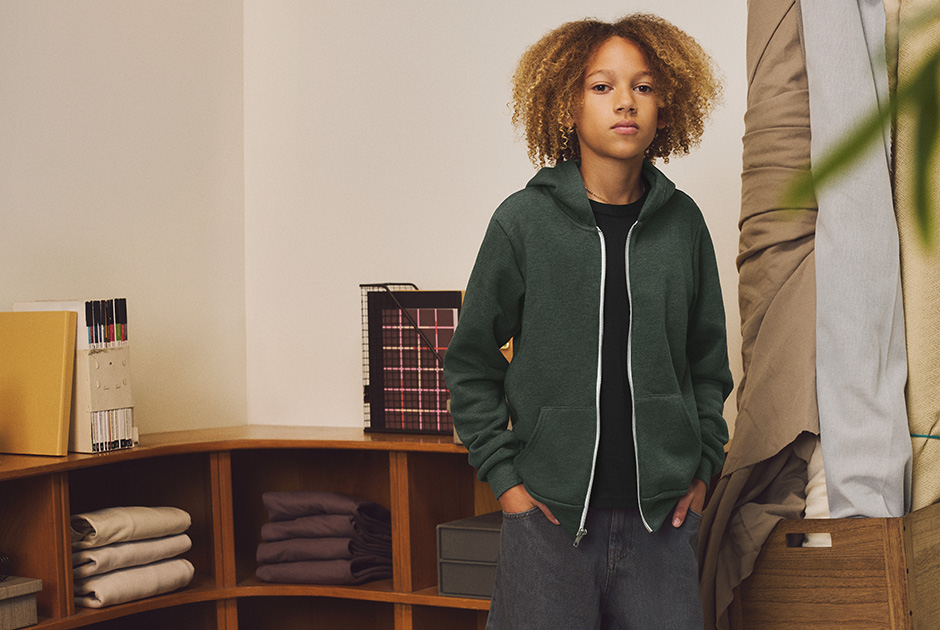Generation Alpha, the children of Millennials, are trendsetters in their own right, even as they parallel the adult apparel market. Children aren’t the end buyers, with their parents having the purchasing power, but children’s voices are loud and are much more influenced by social media than any other generation.
No matter how you look at it, the youth and childrenswear market for 2025 and beyond is a strong one, with a couple of the dominant buzzwords this year being “mini me” and “comfort.” Sustainability is also important.
“The 2025 childrenswear and youthwear market is characterized by a blend of innovation, inclusivity and self-expression. Brands are responding to evolving consumer values, emphasizing sustainability, functionality and personalization,” said Amit Gupta, CEO of Monag Apparel.
“Today’s youthwear consumers want apparel that fits into busy, active lives while also aligning with their principles, whether that’s sustainability, inclusivity or ethical sourcing,” agreed Courtney Karam, director of marketing with Citadel Brands.
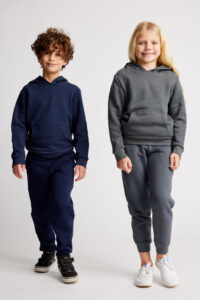
Soft and extremely comfortable, the Fashion Fleece Pullover Hoodie and Jogger Sweatpant offer a true go-to fit for your kiddos. Photo courtesy of Royal Apparel
Consumer Demands in Childrenswear: Sustainability, Quality, and Affordability
Again, today’s buyers value sustainability and ethical sourcing, as well as versatility, durability and easy-care fabrics. Consumers are also demanding choices in both color and fit, observed José Miguel García Botello, executive manager of YazbekUSA.
Eco-conscious consumers, in particular, of which there are many, are demanding more of their manufacturers, including transparency in sourcing. “Parents value quality, safety, durability, style and comfort. Kids, especially tweens, care about style and self-expression,” said Glen Brumer, sales director Royal Apparel.
That said, according to Michelle Yu, creative director of design at BELLA + CANVAS, cost is also an important factor in parents’ purchasing decisions, especially as children tend to quickly outgrow clothing. Gupta agreed, adding, “While quality is essential, affordability remains a critical factor. Parents look for durable clothing that offers long-term value.”
Similarly, Karam said, “Parents want to know that garments will withstand repeated wash and wear, that sizes are true and inclusive, and that materials feel great on sensitive skin. Meanwhile, kids are increasingly vocal about what they wear—they want bold color options, modern fits, and styles that reflect their personality.”
Top Youthwear Styles for 2025: Retro, Gender-Neutral, and Mini-Me Matching Looks
In terms of specific trends, a number of them are very much in play this year including:
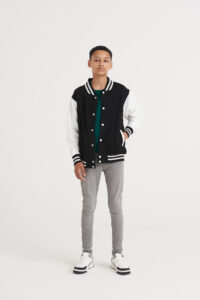
The youth Letterman Jacket is an American-inspired kids’ varsity jacket, complete with contrast sleeves and fashioned from easy-to-decorate heavyweight fabric. Photo courtesy of Citadel Brands
Matching: “‘Mini-me’ clothing is the buzzword for 2025 in childrenswear, referring to matching adults and kids’ styles. These work incredibly well within retail markets and within teamwear,” said Grace Owen, TriDri brand manager. At TriDri, for example, she said they do well with their matching Maria women’s and girls’ hoodies that pair perfectly with their Maria joggers, which she said works for dance clubs, cheer classes or just matching for the sake of it.
“Kids’ clothing mirroring adult fashion, coordinated ‘mommy & me’ or ‘family matching’ outfits remain a hit, especially around holidays or special occasions,” added Gupta.
Retro: What goes around comes around: perhaps because Millennials are the end consumers for their Gen Alpha children’s clothing, it is unsurprising that nostalgic, retro styles, particularly ’90s-inspired styles, like denim, stonewashed, overalls and color-blocked jackets are being reimagined for a new generation. Many of these styles also reflect streetwear, with children emulating adult-street style. Yu said that this also includes ’90s and early 2000s styles “in miniature,” like checkerboards, cargo pants and logo sweatshirts.
Another retro style among children is what Gupta called utility-core: cargo pockets, tech fabrics and hiking-inspired details.
Gender Inclusivity: Gender neutrality is very much on trend this year in this apparel category. “Unisex styles are taking center stage, prioritizing comfort and flexibility. Think neutral colors and timeless patterns that let kids express themselves freely—no more sticking to old-fashioned gender rules,” said Tami Miller, director of creative marketing at LAT Apparel.
Materials Matter: Eco-Friendly Fabrics and Comfort-Focused Clothing
As has been the case for a number of years now, more and more consumers are becoming eco-conscious. Not only that, but this awareness now extends to demands that clothing be manufactured responsibly as well.
That said, Owen emphasized, “There is still a lot of room for growth and demand within this area,” though in the case of TriDri, Owen said, “We have gone as far as certifying our products to Global Recycled Standard [and] future proofing our styles to help with the longevity of the products we offer.”
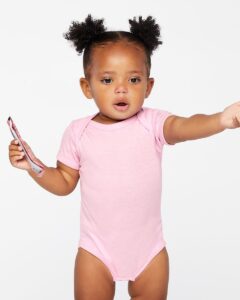
Rabbit Skins Infant 5.0-ounce Baby Rib Bodysuit is made of 100-percent combed ring-spun cotton with an
innovative three snap closure. Photo courtesy of Atlantic Coast Cotton
Along these same lines, Miller said, “Brands are [increasingly] embracing eco-friendly fabrics and ethical production, using organic materials and sustainable processes to satisfy today’s eco-conscious families.”
With respect to comfort, since the pandemic, comfort has reigned supreme, and there is no going back. The result has been manufacturers responding with blends that are both comfortable and soft, such as TriDri’s 60/40 recycled cotton loungewear pieces that have a super-soft brushed fleece inner lining.
Comfort is especially key for active kids, with manufacturers trying to address that by making clothes that do not interfere with movement. Comfort also goes hand-in-hand with sensory-friendliness, another key element that drives consumers of childrenswear.
Interestingly, Karam noted that while comfort remains important, something that has changed in 2025 is the definition of comfort. “It’s not just about softness anymore, it’s about movement, breathability, emotional comfort and even social confidence. Youth apparel needs to support a full day of activities, from school to aftercare to sports and downtime, without the need to change clothes.”
Gupta agreed that kids’ clothes are about everything from soft fabrics to stretch waists and relaxed fits, whether the category is playwear or even dressier clothes. “The goal is clothes they can move, play and nap in. Comfort is non-negotiable, especially for toddlers and active kids.”
“Comfort is still king,” said Oliver Wickiser, marketing director of Atlantic Coast Cotton. “Parents who are the primary buyers prioritize clothing that their kids will actually wear without complaints.”
As for specific materials, Gupta pointed to organic cotton for environmentally-conscious parents, recycled polyester, primarily for outerwear and performance wear, and cotton/modal and cotton/spandex blends.
In terms of materials, Brumer noted that in addition to organic cotton, RPET blends are also gaining traction for their sustainability and softness.
Youthwear Fits and Silhouettes: Relaxed, Oversized, and Adjustable Styles
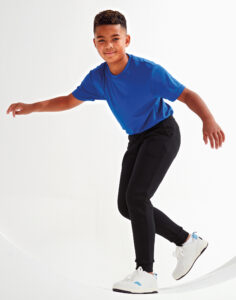
This youth Unisex Ashley Jogger is made of recycled polyester and ideal for screen printing and/or transfers.
Photo courtesy of TriDri
Moving on to fit, today’s trends include relaxed-fit tees with drop shoulders, stretch leggings and joggers, easy-on crewnecks and pull-on bottoms, hoodies that can be layered and shackets (shirt-jacket combos).
Of course, this oversized trend impacts comfort as well, a factor Botello said is equally true for girls and boys. It is also reflective of and influenced by streetwear and comfort-driven design, Wickiser said, citing drop shoulders, boxy tees and slouchy joggers as examples.
Yu noted these loose fits are especially practical for younger children, because it makes getting them dressed and undressed a bit easier. Mix in fitted and loose silhouettes—like snug tops paired with roomy bottoms—and you get the best of both worlds, Miller pointed out.
Similarly, Miller noted the way athleisure-inspired styles, like joggers with elastic waistbands and drop-crotch pants are now everywhere, and that classic, tailored pieces are also making a comeback, especially with tweens. “Think structured jackets, culottes and A-line dresses,” Miller said, with adjustable details, such as elastic bands and drawstrings also help provide room for kids to grow.
“There’s also growing demand for adjustable fits that extend garment life, like longer cuffs and room-to-grow waistbands,” said Karam.
Colors and Patterns: From Dopamine Dressing to Earthy Neutrals
When it comes to colors in childrenswear, pretty much anything goes.
“The standout palette for 2025 is all about optimism with an edge—think soft pastels meeting saturated brights and tonal layering grounded by earthy neutrals. Acid green, orchid purple, digital blues and dusty apricots are also having a moment, often styled monochromatically. Patterns are minimal but impactful, with blurred camo, checkerboard accents and nature-inspired motifs like mushrooms or suns emerging as playful statements,” said Karam.
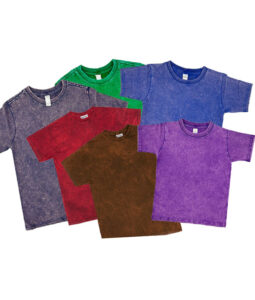
Infant and youth Vintage Wash T-shirts provide plenty of retro flair. Photo courtesy of MONAG
Gender-inclusive is another one of the buzzwords that applies to color as well as style. “More parents are leaning into unisex silhouettes and colors, moving away from rigid pinks and blues. Tones like terracotta, eucalyptus green, oatmeal, clay and dusty rose have become popular. Earthy tones, playful prints and minimal designs appeal to modern, inclusive families,” said Gupta.
Which is not to say there aren’t other options. Even with the current emphasis on earth tones, with pop accents like neon zippers or trims, Gupta says there is still room for what he calls “retro primaries.” Think tomato red, golden yellow or cobalt blue, often in color-block styles. Muted brights, like neon tones with a chalky, matte finish, can also be found.
“Our line is heavily influenced by the adult color trends, but in general we see a trend of youth apparel having and wanting more fashion forward colors, and expanding from the classic basic colors,” said Taylor Rambo, product developer with Independent Trading Company. “A lot of brands are really loving our earth tone colors, like Brown, Bone, Storm Blue and unique camo colors like Duck Camo and Deadwood Tree Camo,” he added.
At the same time, in addition to this trend toward neutral colors, the children’s demographic remains very amenable to bright colors, what Wickiser described as colors that reflect joy and optimism, including “bright, saturated hues like tangerine, cobalt blue, citrus yellow and fuchsia energize wardrobes.”
Yu agreed, noting what she described as the appeal of “dopamine dressing”—dressing for a good mood through the use of, “Bright colors and playful prints to inspire joy and energy.”
Along these same lines Miller said, “Bright and cheerful hues, like cherry red, baby pink, buttery yellow and tangerine are lighting up kids’ wardrobes, bringing a burst of energy and happiness to every outfit.”
Miller added playful, whimsical prints, like animal prints, are being shown as well, as are nature-themed, botanical motifs and other textures inspired by the great outdoors.
The Influence of Social Media on Kids’ Fashion Trends
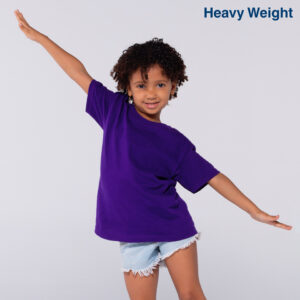
This Kid’s Unisex Heavy Weight Crew Neck Short Sleeve T-Shirt is perfect for multiple decoration methods, including embroidery, DTG and heat transfer. Photo courtesy of Yazbek USA
They may be young, but they already have a loud voice, as today’s youth are both influencers and being influenced by adults when it comes to fashion. Not only that, but with their access to social media (and already being one of the biggest users of social media) it’s never been easier to trace the line between fashion styles online and styles that come to market.
“Kids’ clothing follows takedowns of adult styles (e.g., athleisure, matching sets). Kids, especially tweens and teens, are increasingly trendsetters via platforms like Instagram and TikTok, where child influencers and parent-child coordinated looks,” said Brumer.
“Social media platforms like TikTok and YouTube Shorts have completely flattened the trend cycle. Kids aren’t just mimicking what they see adults wear—they’re remixing it, making it their own and influencing the adult market right back,” agreed Karam.
“Social media plays a huge role as does celebrity and influencer endorsements—more for teens and young adults. Every day they are bombarded with images of their favorite celebrity-singer, team player or whoever they follow, wearing X, Y or Z, and even if it may not be a brand endorsing the post, it becomes a fashion statement,” said Botello.
“With social media and an online presence becoming the norm, children are being influenced and inspired from an increasingly young age,” agreed Owen. “Add to this the continuing leaps in AI technology, and it’s increasingly rare for people not to be using the web for help and inspiration when making purchases.”
Leveraging Social Media: How Brands Can Reach Gen Alpha and Parents
With this in mind, companies need to do their best to leverage social media in order to capture this all-important market. “We had to include and create more appealing and diverse photos, with different styles across all models in the line, to better influence our customers and make them feel more connected,” explained Botello of YazbekUSA effort’s.
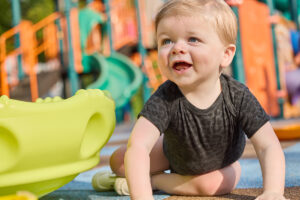
Rabbit Skins Infant Fine Jersey Bodysuit is a one-piece featuring lap shoulders to make it easier for multiple changes throughout the day. Photo courtesy of LAT Apparel
“Social media is a great place for brands of all sizes to float new colors and garment styles out there and see the response. I think that open market of ideas accelerates trends to either grow quickly or burn out,” agreed Rambo.
Noting the way social media plays a major, multidimensional role in influencing fashion trends for the childrenswear/youthwear category, impacting everything from what kids want to wear to how parents shop and what retailers stock, Wickiser said of their company, “We try to market what is trending and reach a different audience than the regular customers who are guaranteed to order every day. This gives us a different outreach, especially as we promote on social media before or after a tradeshow.”
Similarly, Miller said that marketing must include winning over their caregivers, who are digital natives. “For this audience, social media isn’t just a channel—it’s the lifeblood of building brand awareness, loyalty and community,” she said.
As for Citadel Brands’, Karam, she said the company focuses on visual storytelling to leverage social media with bold, upbeat and inclusive content that showcases its youth styles in motion, in context and in trend-aligned styling. “We aim to reflect how kids actually wear our product: to school, at events, or just hanging out. Whether it’s via our own channels or through partnerships with creatives and print wear influencers, we look for ways to show off the versatility and personality of [our] apparel in real-life moments that resonate,” Karam said.
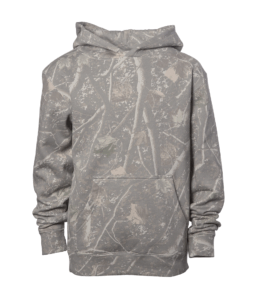
This youth Midweight Pullover Hood is made with the 8.5-ounce midweight fabric from Independent’s Standard Supply Collection. Photo courtesy of Independent Trading Co.
Technologies Shaping Youthwear in 2025
Finally, in the youth segment, a number of technologies are rapidly evolving, including techniques like Dope Dyeing, CO₂ dyeing and laser finishing are all gaining ground in youth garments, particularly for eco-conscious collections, Wickiser said.
Along these same lines, Rambo described some of the updated technologies his company has implemented. “All of our factories have automatic cutting tables that can cut up to 25 layers of fabric into our garment panels with precision. We also have automatic pocket sewing machines that sew the pouch pocket on in a near perfect shape all the time. We also utilize a hanging system that sends the garment from station to station so after each step the garment is hung up and it proceeds to the next step. This is very organized and keeps garments off the floor, saving time and keeping everything organized,” he explained.
As for Botello, he said, “Most of the technological innovations we are seeing have to do with the creation of new and special colors that were previously difficult to achieve, in addition to the search for producing better threads to create softer garments in the market.”
The Future of the Childrenswear Market
Looking ahead most industry experts said they remained confident about the strength of the market in the coming year or two. “We predict growth within this market; childrenswear has been increasingly requested and this is something we have invested in and continue to look at,” said Owen.
“The childrenswear/youthwear market is expected to show strong, sustained growth in 2025 and beyond—driven by demographic trends, digital influence, and increasing demand for quality, comfort, and self-expression in kids’ fashion,” agreed Wickiser.
Hilary Daninhirsch is an award-winning freelance writer based in Pittsburgh. Her work has been featured in a number of lifestyle and trade magazines. She can be reached at [email protected] or hilarydaninhirsch.journoportfolio.com.

